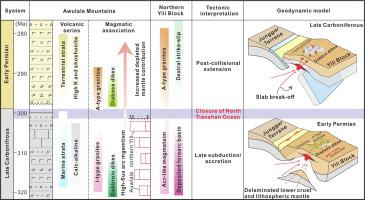Gondwana Research ( IF 7.2 ) Pub Date : 2022-06-06 , DOI: 10.1016/j.gr.2022.06.002 Qing Sun , Xiaobo Zhao , Chunji Xue , Reimar Seltmann , Sean H. McClenaghan , Haixia Chu , Min Wang

|
The evolution of the western Tianshan Orogen in the southern Central Asian Orogenic Belt involved prolonged accretion and collision processes in response to the closure of the Paleo-Asian Ocean during the Late Paleozoic. However, the timing for the tectonic transition from subduction to post-collision is still poorly constrained. Herein, we address this issue based on geochronological, geochemical and Sr-Nd-Hf isotopic investigations on representative mafic dikes from the Awulale Mountains in the heart of the western Tianshan. Zircon U-Pb dating suggest two episodes of mafic magmatism during the Late Carboniferous (ca. 324–310 Ma) and Early Permian (ca. 299–290 Ma). The Late Carboniferous gabbro dikes exhibit large variations in MgO (2.79–10.97 wt%) and Ni (7.58–244 ppm), and arc-like trace element patterns with high Th/Yb (0.55–2.26) ratios, relatively low εNd(t) (+0.2 to +2.5) and variable εHf(t) (+1.3 to +10.4) values, indicating that they were derived from fractional crystallization of a peridotite-bearing mantle source metasomatized by sediment-derived hydrous melts. In contrast, the Early Permian diabase dikes have slightly variable MgO (5.88–7.78 wt%) and Ni (59.90–104 ppm) with apparently low Th/Yb ratios (0.20–0.34, except for one sample: 0.86) and depleted εNd(t) (+5.0 to +7.8) and εHf(t) (+8.0 to +14.6) values, which indicates derivation from partial melting of a juvenile lithospheric mantle source with contributions from early subduction metasomatic components. In context with relevant published data, our study indicates that the Late Carboniferous magmatism of the Awulale Mountains was likely induced by breakoff of the North Tianshan oceanic slab during ongoing subduction; conversely, the Early Permian magmatism may have originated from delamination of the lower crust and lithospheric mantle in the subsequent post-collisional setting. Furthermore, the tectonic transition from Carboniferous subduction to Permian post-collisional extension of the western Tianshan suggests that terminal closure of the North Tianshan Ocean took place at Carboniferous-Permian boundary at ∼ 300 Ma.
中文翻译:

西天山造山带两期晚古生代镁铁质岩浆作用:从石炭纪俯冲到二叠纪碰撞后伸展
中亚造山带南部西天山造山带的演化,伴随着晚古生代古亚洲洋的闭合,经历了长时间的吸积和碰撞过程。然而,从俯冲到碰撞后的构造过渡的时间仍然受到很少的限制。在此,我们基于对西天山中部阿乌拉莱山脉代表性镁铁质岩脉的年代学、地球化学和 Sr-Nd-Hf 同位素研究来解决这个问题。锆石 U-Pb 测年表明晚石炭世(约 324-310 Ma)和早二叠世(约 299-290 Ma)发生了两次镁铁质岩浆作用。晚石炭世辉长岩脉在 MgO(2.79-10.97 wt%)和 Ni(7.58-244 ppm)中表现出很大的变化,以及具有高 Th/Yb(0.55-2.26)比率的弧状微量元素模式,(t) (+0.2 到 +2.5) 和可变 εHf (t) (+1.3 到 +10.4) 值,表明它们来自于由沉积物衍生的含水熔体交代的含橄榄岩地幔源的分级结晶。相比之下,早二叠世辉绿岩岩脉的 MgO(5.88-7.78 wt%)和 Ni(59.90-104 ppm)具有明显低的 Th/Yb 比率(0.20-0.34,除了一个样品:0.86)和耗尽的 εNd ( t) (+5.0 至 +7.8) 和 εHf (t)(+8.0 到 +14.6)值,这表明来自早期俯冲交代成分的贡献的幼年岩石圈地幔源的部分熔融。结合已发表的相关数据,我们的研究表明,阿乌拉莱山脉晚石炭世岩浆作用可能是由北天山洋板在持续俯冲过程中断裂引起的;相反,早二叠世岩浆作用可能起源于下地壳和岩石圈地幔在随后的碰撞后环境中的剥离。此外,西天山从石炭纪俯冲到二叠纪碰撞后伸展的构造转变表明,北天山洋的最终闭合发生在~300 Ma的石炭-二叠纪边界。











































 京公网安备 11010802027423号
京公网安备 11010802027423号